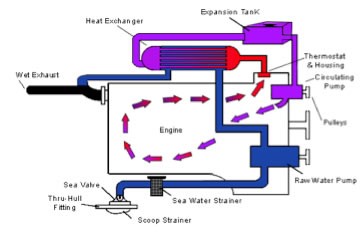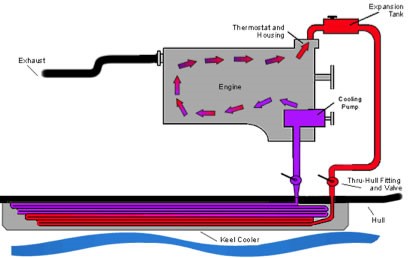Maine engine Cooling systems
-
Heat Exchanger and Marine Cooling Systems
Marine engines, as well as automotive engines, cooled by circulating water through the engine block. Marine engines are specific with two different types of cooling systems, standard raw water system and the fresh water cooling system (commonly known as closed system).
- Raw Water Cooling Systems
Raw(Sea) water cooling systems draw water outside the boat (seawater or lake water). Water is pumped from the source to engine block then the engine circulation pump forces the raw water go through the engine block and expelled through exhaust manifold. Raw water cooling systems are relatively simple as the standard cooling system on most Marine Engines. Raw water pump in most cases is inside the outdrive.
For larger power and inboard engines, the raw water pump is located inside the boat and driven by v-belt or directly off from the crankshaft. The danger is using salt water cooling in your engine, it can be highly corrosive. Running salt water go through your engine block and exhaust manifolds will lead to destructive corrosion, which is unseen until your engine or exhaust manifolds fails.
Generally speaking, marine engines cooled with raw water, especially salt water, has a shorter operation life compared marine engines cooled with a closed cooling system.
- Fresh Water Systems Heat Exchanger and Keel Cooled systems
Fresh water cooling systems, also known as closed cooling systems, has several varieties. The most common type uses a Heat Exchanger which functions similarly to the radiator in your car. Coolant (antifreeze) is circulated through one side of heat exchanger, and it is cooled by raw water passing through the other side of the heat exchanger. The engine coolant circulated back into the engine and the raw water expelled out of the boat through the exhaust.
Another common type of closed cooling systems is known as a Keel Cooler. This is done by eliminating the heat exchanger. Instead of pumping raw water into the vessel’s heat exchanger cooling the coolant, the coolant is pumped through pipes or aluminium extrusions outside the hull where the surrounding water (lake, river or sea water) cools the coolant before it is pumped back into the engine. The use of keel coolers removes the need for a heat exchanger, raw water pump and the other components necessary for pumping raw water into the heat exchanger.
Fresh Water Cooling examples
 |
 |
Closed cooling systems are more complex than raw water cooling systems, but have distinct advantages:
- Minimal internal engine corrosion.
- More effective at cooling the engine and allows your engine run at higher temperatures, resulting in better engine performance and fuel economy.
How A Heat Exchanger Functions
A heat exchanger transfers, or “exchanges”, heat from your boat engine’s coolant to raw water pumped outside of your boat. The raw water is pumped through a bundle of small tubes in a chamber filled with the hot engine coolant. The tubes are cooled by the colder raw water, which allows the tubes to absorb the heat of the engine coolant.
To function correctly, a heat exchanger must be carefully matched to your boat’s engine.
Expansion Tanks
Expansion tanks are often overlooked but a very important part of closed cooling system. As the engine coolant turns to hot, it expands to increase the volume. In some systems, the heat exchanger is a piggy back style and it’s why the expansion tank is built on top of the Heat Exchanger.
In some Heat Exchanger systems, the expansion tank is a separate tank remotely mounted. Another important part of the heat exchanger is expansion tank cap, similar to the cap on your car radiator, it helps maintain your cooling system pressure. It should be checked regularly for leakage and corrosion and replaced every two years.
Different types of Cummins marine engines
Marine M1: Continuous Working Boat with Full Load. More Than 12 Hours a Day, 5 Days a Week.
For marine propulsion applications that may operate up to 24 hours per day at uninterrupted full power. These applications typically operate over 3000 hours per year and have load factors over 65%. The M1 rating is ISO 8665 “standard power” and SAE J1228 “crankshaft power” rating.
Marine M2: Heavy Duty Working Boat. Loaded and Unloaded. Up to 12 Hours a Day, 5 Days a Week.
For marine propulsion applications that operate up to 3000 hours per year and have load factors up to 65%. This rating is for applications that are in continuous use, and use full power for less than 16 hours out of each 24 hours of operation. The remaining time of operation must be at cruising speeds.
Marine M3: Medium Duty Working Boat. Loaded and Unloaded. Up to 8 Hours a Day.
For marine propulsion applications that operate up to 2000 hours per year and have load factors up to 50%. This rating is for applications that use full power for less than 4 hours out of each 12 hours of operation. The remaining time of operation must be at cruising speeds.
Marine M4: Light Duty Working Boat. Loaded and Unloaded. About 4 Hours a Day.
For marine propulsion applications that operate up to 800 hours per year and have load factors below 40%. This rating is for applications that use full power for no more than 1 hour out of each 12 hours of operation. The remaining time of operation must be at cruising speeds.
Marine M5: Pleasure Boat, Light Loads, Weekend Usage.
For marine propulsion applications that operate 300 hours and less per year and have load factors below 35%. This rating is for applications that use full power for less than 30 minutes out of each 8 hours of operation and do not operate for the remaining 16 hours of the day.
